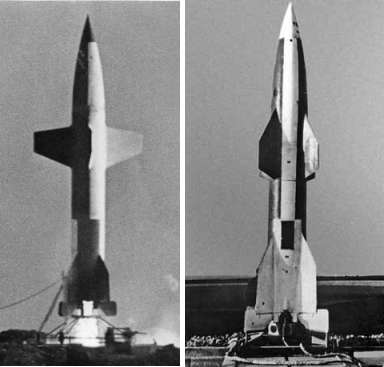The Elsass radio command system used a Mannheim radar for target tracking, a Rheingold radar for missile tracking, and a Kehlheim radio link for command transmission.
Of all of the German SAM systems, the Wasserfall had by far the greatest potential, and had it entered operational service in early 1944 could have inflicted heavy losses on Allied heavy bomber fleets. Fortunately, the Nazi leadership were obsessed with bombarding Britain with strategically useless A-4/V- 2 ballistic missiles, and put their funding into that program, launching over 3000 weapons for negligible military effect. Had the prodigious effort invested into the A-4/V-2 program been put into the Wasserfall, the course of the war could have been very different. The Wasserfall produced most effective in providing a baseline for postwar US and Soviet SAM designs.
The airframe of the earliest Wasserfall W-1 was a scaled down derivative of the A-4/V-2 design, with an ogival taper, cylindrical fuselage, and additional cruciform centre fuselage wings to increase the missile’s achievable turn rate and glide performance. Like the A-4/V-2, the Wasserfall was launched vertically from a mobile pad, emplaced from a transloader truck or trailer.
The first launch attempt in January 1944 failed, with a pad explosion, but by the end of the war between 25 and 40 successful firings were performed, some with prototype guidance systems installed. Over this period, the airframe design evolved to the W-5 configuration, with shorter span and wider chord wings and larger tail, and the final scaled down W-10 configuration, with a smaller diameter and shorter fuselage and spans. The Wasserfall W-10 weighed 3500kg, had a diameter of 0.72m, a wingspan of 1.584m and length of 6.128m.
Achieved performance varies with sources, with the W-5 usually credited with a top speed of 2736km/h, ceiling of 60,000ft and range of around 14 nautical miles. This is similar performance to the much later Soviet SA-3/S-125 Pechora/Goa SAM, but using a heavier single stage airframe. Initial warhead was designed to use 100kg of conventional explosive, later replaced with 300kg or liquid explosive, using proximity or command link fusing. German sources put the unit production cost of the Wasserfall at 7,000 -10,000 Reichmarks, using 1/8th of the manhours to produce the strategically ineffective A-4/V-2 missile.
The guidance and control scheme is of particular interest. The missile used a gyro autopilot for pitch/roll/yaw control, with pitch, roll and yaw control forces generated by mechanically coupled tail surfaces and graphite thrust vectoring vanes in the exhaust, an arrangement found today in many missiles with TVC capability.
Three guidance schemes were in development. The baseline system used a radio command link, with an operator using a joystick to steer the missile to impact, a formidable task even against a 150 KTAS cruising piston engine heavy bomber.
Two more advanced radar guidance schemes were in development. The first was the Rheinland, which was a manual command to line of sight system, using a transponder beacon in the missile and a tracking radar for both missile and target, allowing night attacks on RAF bombers or daylight attacks through an overcast. The second system has to have been a beam-riding automatic guidance system, using two orthogonal fan shaped beams, which rotated as the beam tracked the target. In the latter system, the missile would automatically ride the beam to impact.
It is interesting that the rotating reticle infrared seeker, developed by von Braun for the A- 4/V-2 and used to this very day, never found its way into the Wasserfall program. The Wasserfall program was suspended in February 1945, as Soviet forces overran East Prussia. The Luftwaffe had ambitious plans for the Wasserfall, envisaging 200 batteries installed in three SAM belts across Germany, requiring monthly production of 5,000 Wasserfall reload rounds. The never implemented plan would have seen the first operational battery in November 1945, with twenty sites operational by March 1946.
